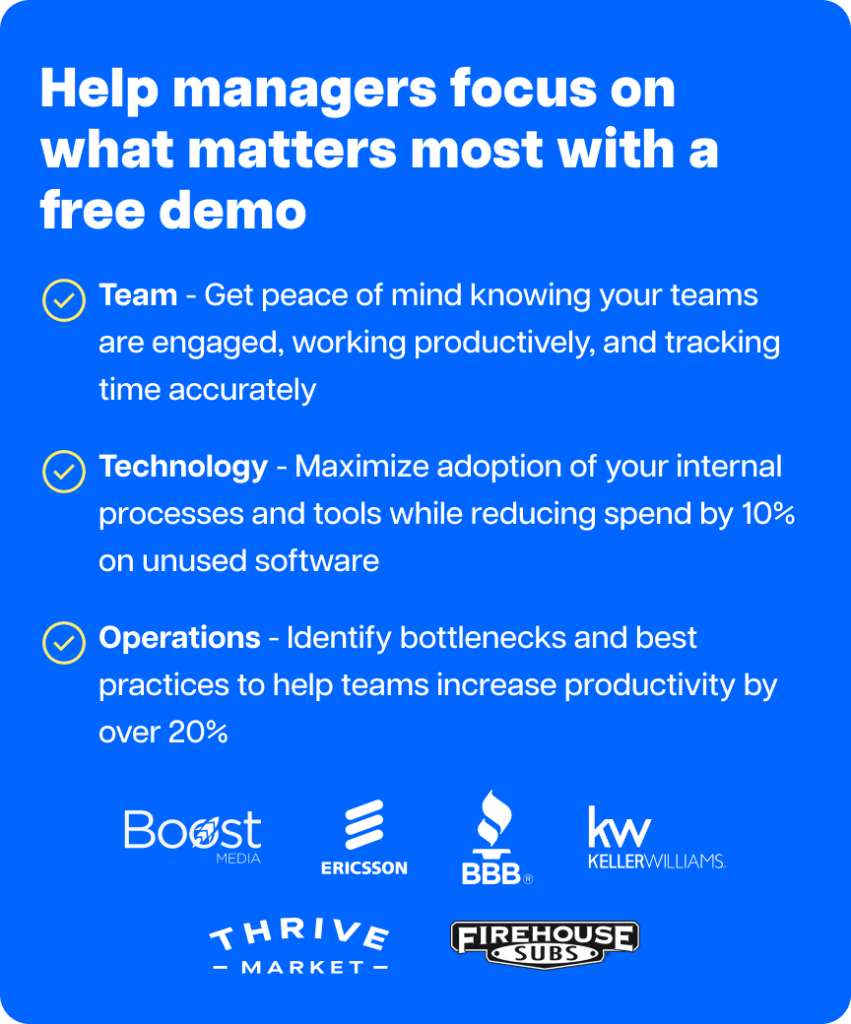You may be a hard-working employee and an excellent team player. Yet you may feel like you’re stuck in your career.
Why?
That’s because your leader may not be aware of your work or the positive impact you’re creating in the company. This is why you should work on enhancing your workplace visibility.
Workplace visibility basically means being recognized for your contributions and being included in your company’s major decision-making processes, whether you work from home or on-site.
So how do you make yourself seen and heard?
In this article, we’ll cover ten amazing tips to increase visibility at work. We’ll also discuss five ways in which managers can help their employees attain greater visibility.
Table of Contents
- 10 incredibly effective ways to increase visibility at work
- Top 5 tips for managers to ensure employee visibility
Let’s get started!
10 incredibly effective ways to increase visibility at work
Here are ten essential tips to help you attain high visibility at your workplace:
1. Show initiative
Showing initiative means going that extra mile or doing something beyond your regular responsibilities. This is an essential skill for a person aiming for a leadership role.
The key here is to continuously find ways to be resourceful and take action before you’re told to.
Here are a few tips for building your initiative muscles, irrespective of where you work from:
- Update your work status with your team members and managers.
- Deliver quality work for all your assigned tasks.
- Refer good job seekers to your HR team.
- Volunteer for leadership positions.
- Support your senior leader efficiently by taking on more responsibilities.
Developing the habit of taking initiative helps you become a good decision-maker. You learn to weigh the pros and cons of each opportunity strategically.
As a result, you can capitalize on advancement opportunities and accelerate your professional development.
2. Be proactive at company events
Besides hard work and meeting deadlines on time, off-work effort is also essential to increase your visibility.
For example, you can represent your team in company events like sports or help organize fundraisers. If you’re a part of a remote team, you may also plan fun virtual weekly ice-breaker activities like online truth or dare games for remote employees.
This will give you instant visibility as you connect with your team members and help enhance the company’s work culture.
3. Speak up during team meetings
Voicing opinions and asking questions during an office meeting or conference call is an excellent opportunity to express your unique ideas with the team and increase visibility.
For people who don’t have the confidence to speak up during in-person (on-site teams) or virtual team meetings (remote teams), these tips may help you:
- Prepare questions in advance by going through the meeting agenda.
- Dress-up professionally.
- Opt for video meetings with the camera on to increase visibility.
- Maintain eye contact with the main speaker in the meeting to exude confidence.
Check out this blog for other tips on virtual team meetings.
Speaking up often and contributing meaningfully to team meetings reduces your anonymity as you interact with coworkers and build good work relationships.
4. Participate in other internal communication
Never hesitate to start conversations or ask good questions. However, before you speak, listen carefully to conversations, and weigh the pros and cons before you add to the discussion. It ensures that you’re a valuable contributor to the conversation.
In-person conversations may not be possible if you work from home. In such cases, team chats or a conference call are a great way to connect with your coworkers and be visible.
You can suggest topic threads or create specific chat rooms for shared interests like music, books, movies, and more.
Additionally, you can create specific channels for different projects so that the entire team gets regular updates on project progress.
These efforts will make you look like someone who is committed to developing the team and the company.
5. Build stronger relationships
According to the LinkedIn Opportunity Index (2020), 76% of the respondents believe that knowing the right people helps you advance in life.
So how do you build a good network?
Here are a few helpful tips to build stronger relationships in both remote and on-site workplaces.
- Write down why you want to network. This helps you choose the best people to network with.
- Attend networking events and use social media platforms like LinkedIn to build connections outside your workplace.
- Organize a meet-up and dinner with your colleagues after work.
- Develop partnerships that benefit both parties. For example, you can introduce your new connections to some of your old networks.
- Stay in touch with your connections.
Following these steps will ensure you build stronger relationships that enhance team work, increase visibility, and bring you great career opportunities.
6. Leverage your strengths
To make the most of your strengths, you must first know your current visibility level. This will help you understand how much you need to work on your strengths and measure your progress.
These questions may help you determine your present visibility levels:
- Did your work have any positive impact on the company?
- Did you increase your company’s productivity?
- How many projects or tasks could you do within a specific time frame?
Then you can implement these steps to leverage your strengths:
- Set career goals and build a strategy to use your strengths to achieve them.
- Show evidence of your strengths like certifications, work achievements, etc.
- Improve hard skills (technical, project management, etc.) and soft skills (problem-solving, leadership, etc.).
Irrespective of your work setting, your best efforts will make you more noticeable in the eyes of your boss, peers, and clients. It’ll also hone your leadership skills and push you to the next level.
7. Volunteer for high visibility projects
Ask for high visibility projects that’ll test your skills and help you collaborate with a senior leader, taking you closer to your career goals.
Your professional visibility will increase when people see you as a proactive employee who is willing to work outside their comfort zone.
However, while you should voluntarily take up high profile projects, it shouldn’t be your sole focus. You should find a balance between regular and high-profile projects. This ensures you’re never overburdened and can give your best when it matters the most.
8. Suggest strategic improvements like cost cutting measures
You can find an opportunity to improve your professional visibility by suggesting a great strategy to cut company costs, for instance.
It could be ideas such as:
- Adopt cloud computing and open source software.
- Collaborate with small businesses to buy machinery, software, etc..
- Barter services with other businesses. For example, a content agency looking for a productivity tool can exchange content services for a time tracking tool instead of money.
This shows that you’re concerned about the company’s bottom line and are thinking of ways to optimize resources. This makes the management look at you for solutions, increasing your visibility.
9. Upskill yourself
Develop your skill set by taking additional courses to keep up with the ever-changing market needs.
Make sure you choose a skill or talent that helps you stand out from your coworkers.
For example, if you work in a content-marketing agency that lacks an SEO expert, you can train to become one. Companies usually encourage such initiatives as it helps them save on hiring and other human resource management costs.
It’ll help you build strong employee connections as your coworkers may come to you for expert guidance. You can also hold training sessions for other employees.
You’ll soon be an indispensable part of the team. And in the long run, the organization may come to see your potential as a team leader.
10. Celebrate your coworkers’ achievements
Everybody loves a person who celebrates and acknowledges their colleagues’ achievements.
For example, you can congratulate your team member in a group setting, like team meetings. For larger visibility, you can send tweets, or post on LinkedIn for their work anniversaries, promotions, etc.
This will help your team members see you in a positive light. You’ll also be doing your bit to create a positive work culture that celebrates the milestones of every team member.
Now, ensuring the professional visibility of any employee is vital for senior managers as well. That’s because greater visibility motivates employees to work productively and improve the company’s bottom line.
Let’s check out five ways in which managers can adopt an employee visibility strategy.
Top 5 tips for managers to ensure employee visibility
Here are five useful tips for senior managers to increase employee visibility and boost employee engagement in remote and on-site workplaces.
1. Give employees equal access to company resources
Some companies may not give all their employees the required access to company data, technology, and automation tools. As a result, they won’t be able to utilize their talent fully or contribute more to the organization. This can hurt employee morale and work culture.
For example, a customer care employee who doesn’t have complete access to the latest product manuals won’t be able to answer client queries as effectively as their colleague with access.
This is especially true for hybrid and remote teams. You’ll have to take extra care to ensure that your remote teams have the same access as your onsite teams.
2. Encourage participation during team meetings
Managers should encourage all employees to participate during team meetings.
Some members may find it difficult to do so, so managers should check on them and make them a part of the meeting by asking for their opinions and solutions.
Meanwhile, most employees prefer to keep their videos off during remote work and virtual meetings. This would have a negative impact on their workplace visibility.
To counteract this, senior managers should encourage their team for increased face-time to create an atmosphere of a physical meeting. Video meetings also enhance team communication.
For example, during face time, managers and teammates pick up non-verbal cues, which helps avoid misunderstandings and improve team collaboration.
However, this could be tricky if you have both work from home and onsite employees. That’s because an onsite worker tends to get greater visibility than hybrid or remote employees, as the former spends more in-person time with their teammates and leader.
3. Have regular check-ins with employees
Visibility doesn’t just mean monitoring how employees contribute to your company but also checking their well-being and providing them with all the support they need.
You can have regular one-on-one meetings with your employees (especially remote workers) to check on any issues they may face in the organization.
For example, if you find your employees spending a lot of time on certain tasks, you can talk to them to understand and eliminate any issues or bottlenecks they may be facing.
4. Value employee suggestions
Another great way to nurture high visibility is by listening to and implementing employee suggestions.
To do so, you can involve your employees in major decision-making processes. This will give them an opportunity to share potential solutions regarding company issues. And if their suggestions align with company policies, you can implement them.
For this, you can hold innovation competitions or use employee suggestion box apps. These workplace policies can amplify your employees’ visibility, ultimately increasing employee engagement and boosting productivity.
You can track and quantify this increased productivity using an advanced time tracking and employee productivity tool like Time Doctor.
Explore more of Time Doctor features here!
5. Reward employee efforts
Recognition and appreciation are excellent ways to make employees feel visible and heard. You can arrange annual nights and monthly employee awards. Or a remote team can celebrate work achievements on team chat platforms and social media.
You can also nominate the best candidate as the team leader or for any other leadership role.
This is a wonderful way to let your employees know you acknowledge their efforts to help your organization grow. As a result, it’ll boost employee morale and motivate them to take more initiative.
Wrapping up
Employee visibility at work is essential for career success. It can help you with advancement opportunities, well-deserved promotions, and boosted morale.
Managers can help by adopting measures like ensuring equal access to resources, recognizing employee efforts, and supporting them in remote and on-site workplaces.
However, these measures will only work if you put in your best efforts to stay visible.
You can use the pointers mentioned above to step out of your comfort zone and get the recognition you deserve today!

Liam Martin is a serial entrepreneur, co-founder of Time Doctor, Staff.com, and the Running Remote Conference, and author of the Wall Street Journal bestseller, “Running Remote.” He advocates for remote work and helps businesses optimize their remote teams.


